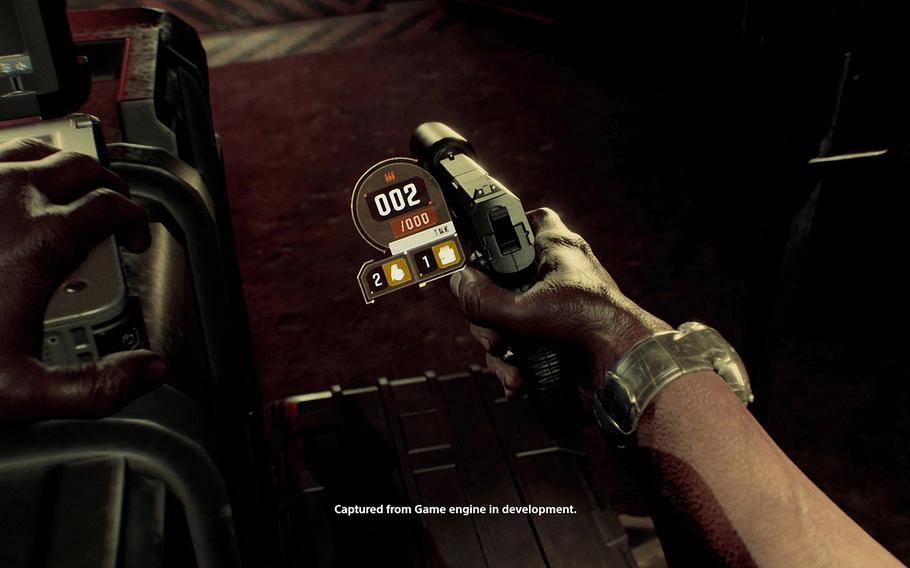
Players in Firewall Ultra have a main weapon, a pistol, a gadget and a grenade of some sort. (Sony Interactive Entertainment/TNS)
One of the most memorable parts about virtual reality is how everything is so intuitive and surreally granular all at once. Instead of pressing a button to bring up the iron sights, a player has to lift the gun to his face and look down the scope. If she wants to crouch, a button would suffice but actually ducking down would also work.
That's one of the things players have to get used to when playing Firewall Ultra, a tactical shooter coming for the PlayStation VR2. Developed by First Contact Entertainment, it's the sequel to the PSVR game that launched in 2018, and it's a game that takes advantage of the leap in technology on the PlayStation 5 and its new headset.
VR Counter-Strike
The game is essentially Counter-Strike except in VR. Players group together in teams of four and take down an opposing squad. One team defends a laptop and another team goes after it. That's a simple concept, but players will come across a multitude of gunfights, traps and games of cat and mouse as they try to outmaneuver and eliminate each other.
It takes a while to get used to the minutiae of combat. In conventional shooters, hitting a button gets things done, but in Firewall Ultra, players have to remember to use their left hand and a button to push open a door. They'll have to physically turn around to check their blind spots or they can tap the right analog stick on the Sense controllers to look in a direction. (That could be a little too slow.)
How to get things done
That's not to say players have to do everything physically with gestures. First Combat actually does a good job of balancing realism with video game convenience. For example, players don't have to pull out a mag and reload by performing a motion. That's all done with a reload button.
Tossing grenades is as simple as picking them from your inventory, lining up a toss and hitting a button. Players don't need to actually do a throwing motion. Just remember, before tossing the grenade, don't be in an elevator in the middle of a firefight. Sometimes you fail to communicate and you toss the grenade while your teammates close the door. I heard that it, uh, doesn't end well.
The developers did use the motion controls for elements more attuned to skill and gameplay such as aiming your weapon. It's a layer of realism that players have to adapt to but it makes the game feel more immersive as players search for the best angle to shoot an opponent during a firefight. They can actually maneuver the weapon to blind fire over cover or peak around a railing to see where enemies are headed. Players can even switch the side they're firing from by grabbing the rifle stock with the right or left h and.
Excellent use of eye tracking
One of the bigger innovations in Firewall Ultra is how First Contact uses eye tracking. Players can choose weapons with their eyes and navigate menus. All of it works well for the most part. But the team thought outside of the box and implemented eye tracking with things such as flashlights and flashbang grenades.
Now, if a rival tries to blind you, you can close your eyes and protect yourself. Because the PSVR2 headset knows your eyes are closed it registers in the game. Each gun also has a flashlight that turns on and off. When shined in the face of an enemy, it will blind them and that can give players enough time to fire some shots.
Of course, players can stop that move by either closing their eyes or they can even splay their hand out in front of them to block the light source for a few precious seconds. It's an intuitive and granular move that works within the context of the game.
One of the more overlooked parts of the PSVR2 is the haptics that is built into the headset. First Contact activates a rumble when players do moves such as dropping from a ledge to a floor down below. It's a nice touch that increases the realism.
Playing through the oil rig and social
In the hands-on preview, we only played two maps, which are revamped one from the original. The first was Oil Rig which features plenty of stairs and rooms. It takes place at night and was a perfect candidate to show off the flashlight effects. The second map was Social, and it's brighter, taking place in a sunlit office building. It has two floors with a main staircase in the center.
In the levels, players have to keep an eye out for details. For example, they could see a camera that will show opponents your location. They can actually shoot them out before that happens. They'll also uncover power-ups that help their side. Some are extenders that give the attacking team more time to hack the target laptop. Other times, they can run into Crypto Mining rings, which give players the in-game currency needed to buy items.
If players die during the match, they can still help the team by sifting through different cameras and using their eyes to spot foes. They'll show up with a red outline to the remaining players. Yes, it's another use of eye tracking.
Lastly, Firewall Ultra is visually light years ahead of the original. One of the obvious improvements is the lighting effects, but the power of the PlayStation 5 also makes the world look more detailed and cleaner through the better display of the PSVR2. There's a distinct clarity that makes online shooters more immersive. You can even read what's written on the whiteboard in a safehouse.
Firewall Ultra is scheduled for release later in the year.